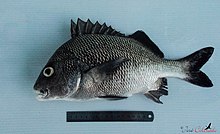The black margate (Anisotremus surinamensis), also known as black bream, black thicklip, dogfish, lippe, Mexican bull, pompon, Spanish grunt, surf bream, sweetlips or thicklip grunt,[3] is a species of marine ray-finned fish, a grunt belonging to the family Haemulidae. It is native to the western Atlantic Ocean.[2]
| Black margate | |
|---|---|

| |
| Scientific classification | |
| Domain: | Eukaryota |
| Kingdom: | Animalia |
| Phylum: | Chordata |
| Class: | Actinopterygii |
| Order: | Acanthuriformes |
| Family: | Haemulidae |
| Genus: | Anisotremus |
| Species: | A. surinamensis
|
| Binomial name | |
| Anisotremus surinamensis (Bloch, 1791)
| |
| Synonyms[2] | |
| |
Description
editThe black margate has a deep, compressed body with a high back and a short, blunt head. The mouth is positioned low on the head, it is horizontal with fleshy lips and the jaws are equipped with bands of teeth on both jaws. The outer band of teeth are conical in shape.[4] It has a greyish-silver body which is darker on the anterior half than the posterior half. The dorsal scales have black centres and the fins are dark grey, the pelvic and anal fins being the darkest.[5] There is a darker pt h to the rear of the pectoral fins.[6] The juveniles have a black stripe along the lateral line and another along the upper back, and a large black spot on base of tail fin.[4] the dorsal fin has 12 spines and 18 soft rays while the anal fin contains 3 spines and 9 soft rays.[2] There is a deep notch in the dorsal fin and the fourth dorsal spine is longer than the others while the second anal spine is also very large.[4] The black margate reaches a maximum total length of 76 cm (30 in), although a total length of 45 cm (18 in) is more typical, while the heaviest specimen recorded was 5.8 kg (13 lb).[2]
Distribution
editThe black margate is found in the warmer parts of the Western Atlantic Ocean. It is found in Florida from Cape Canaveral south through the Florida Keys to the Gulf of Mexico, including the Flower Garden Banks, from Rockport, Texas along the coast of Mexico to the northern Yucatan Peninsula and northwestern Cuba. It occurs throughout the Caribbean Sea then and along the northern and eastern coasts of South America to Rio de Janeiro in Brazil. It also occurs at the Fernando de Noronha and Trindade Island.[1]
Habitat and biology
editThe Black margate shows a preference for steep, sloping rock substrates or rock reefs in inshore waters down to depths of 20 m (66 ft). It frequently takes shelter in caves, ledges and within wrecks. It is normally encountered either as small groups or individuals. It is a nocturnal feeder, its diet including crustaceans, molluscs, smaller fish and urchins.[6] A frequent item in its diet are sea urchins in the genus Diadema.[2] They may gather in spawning aggregations and, off Jamaica, breeding adults have been reported between April and August. Larvae and young juveniles have been observed settling on rocky seabeds off Florida.[1]
Systematics
editThe black margate was first formally described in 1791 as Lutjanus surinamensis by the German naturalist Marcus Elieser Bloch (1723–1799) with the type locality given as Suriname.[7]
Utilisation
editThe black margate is occasionally caught and marketed by fisheries, although the consumption of the flesh of larger fishes has been linked to cases of ciguatera poisoning. They are also found in the aquarium trade.[1]
References
edit- ^ a b c d Lindeman, K.; Anderson, W.; Claro, R.; Padovani-Ferreira, B.; Rocha, L.A.; Sedberry, G. (2016). "Anisotremus surinamensis". IUCN Red List of Threatened Species. 2016: e.T194408A2332935. doi:10.2305/IUCN.UK.2016-1.RLTS.T194408A2332935.en. Retrieved 20 November 2021.
- ^ a b c d e Froese, Rainer; Pauly, Daniel (eds.). "Anisotremus surinamensis". FishBase. December 2019 version.
- ^ "Black Margate (Anisotremus surinamensis)". Whasthatfish. Retrieved 22 March 2019.
- ^ a b c "Species: Anisotremus surinamensis, Black margate". Shorefishes of the Greater Caribbean online information. Smithsonian Tropical Research Institute. Retrieved 22 March 2021.
- ^ MJ de Kluijver; G Gijswijt; I Da Cunda & R De Leon. "Black margate (Anisotremus surinamensis)". Interactive Guide to Caribbean Diving. Marine Species Identification Portal. Retrieved 17 March 2021.
- ^ a b "Black Margate". mexican-Fish.com. 25 December 2014. Retrieved 22 March 2021.
- ^ Eschmeyer, William N.; Fricke, Ron & van der Laan, Richard (eds.). "Species in the genus Anisotremus". Catalog of Fishes. California Academy of Sciences. Retrieved 22 March 2021.
External links
edit- Marinespecies.org
- Photos of Black margate on Sealife Collection
